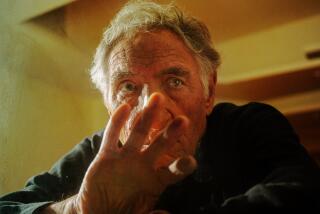Like Doing It All Yourself? Try a Pinhole Camera
- Share via
If all the options of modern photography--the automatic focuses, the zoom lenses, even the computers--sometimes make you wild, you might want to try taking pictures with one of the simplest (and oldest) cameras there is: a pinhole.
Pinhole photography is fun and it isn’t difficult (even children can do it).
You won’t find a pinhole camera in a store, though. This is one you make yourself. You also develop the negatives and make the prints yourself.
To make a pinhole camera, you will need a small cardboard box, regular and double-stick tape, black tape, a brass shim, flat black paint, very fine sandpaper, several plastic developing trays, a pushpin and photography developing paper. The steps:
Making the Pinhole: A brass shim--these are sold at auto parts and hardware stores--works best. The thinner the piece of brass, the better. In it, make the smallest hole you can with the pushpin, then sand the opposite side of the brass to remove the burrs created by the pin. Keep repeating the process, twisting the pin as you push, to make the hole larger. The objective is to make a clean hole. Be sure to smooth down the brass on the other side because rough edges will soften the focus.
Making the Camera Body: The best size for the cardboard box, which will be your housing, is 5 inches by 5 inches. Those dimensions work best with 4-by-5 negative paper (exact size is not important). The most critical aspect of making the camera is that there be a tight fit at the top and at each corner so that no light can get in.
The brass shim will go inside the box, behind a hole you will cut. It’s best to cut the hole smaller than the size of the brass shim.
Next, paint the inside of the box flat black. After the paint dries, affix the brass shim with tape to the inside of the box. Then stick the double-sided tape to inside wall opposite the side holding the brass shim. This is where you will attach the negative (that is, the piece of printing paper you will use to accept the image).
To make a shutter, you can use the piece of cardboard removed to make the hole. Take that piece and tape it on the outside so as to cover the pinhole. You don’t want a loose flap; be sure to keep any tacky residue off the brass.
Now you’re ready to start using your camera:
Film: Buy 10 sheets of single-weight, fiber-based No. 2 photographic paper. For a safelight, buy the lowest-watt red bulb you can find and put it in your usual light fixture. Under a safelight, cut these into smaller 4-by-5 inch sheets. Still under the safelight (or in total darkness), load the paper film into the camera by attaching it to the double-stick tape. You want to have it flat against the camera wall. Remember, keeping the light out is the most important factor.
To Take a Picture: Pick a stationary subject. Because your exposures may be as long as 30 seconds, a person walking in front of your camera will not show up on the film. Simply set the camera on a stable surface, point it at the subject, open the shutter by removing the tape for 30 seconds, then replace the shutter.
Now you are ready to make a negative.
Bathrooms make fine darkrooms. First, though, you need to cover the windows to block out all light. Also check under the door to make sure no light is coming in through there. You will need the plastic trays to develop your paper negative and to make the final print. You will need one tray for the developer, another for water or a stop bath, and another for fixer. For the final wash, you can use either a tray or a sink and running water. (Use print tongs to move your prints because the chemicals can cause problems if you come in contact with them.)
Developing the Paper Negative: Under the safelight, unload your camera and take out the exposed paper negative. Put it in the developer for 2 minutes, then put it into the water or stop bath for 15 seconds, and then in the fixer for 10 minutes. Rinse off the fixer in the next tray, then wash the paper for 30 minutes in running water.
You can return to regular lighting after the print has been in the fixer for at least 1 minute. After you see the paper negative under a white light, you can decide whether your exposure has yielded a good negative.
If it’s all too black, you’ll need to take another shot with a shorter exposure; if it’s too light, lengthen the exposure. Be sure to write down your exposure times and what type of light you were in to keep track.
Making the Print: Once you’ve got a satisfactory negative, you’re ready to print. You can use the same darkroom setup to make prints too, but you’ll also need a flat surface and a piece of glass slightly larger than the negative to make a contact print. No enlarger is needed. Under the safelight, take your negative and lay it atop an unexposed piece of photo paper. It must be placed down emulsion to emulsion--that is, the sides of the paper that are photosensitive must be facing. You are exposing light through your paper negative, so it must be on top. Lay a piece of glass on top of them, then turn on the white light for 1 or 2 seconds. (Be sure the rest of your unexposed photographic paper is put away.) Develop your positive using the same procedure you used to develop the negative.
If the print is too dark or too light, you can reprint with the same negative using a different exposure time.



